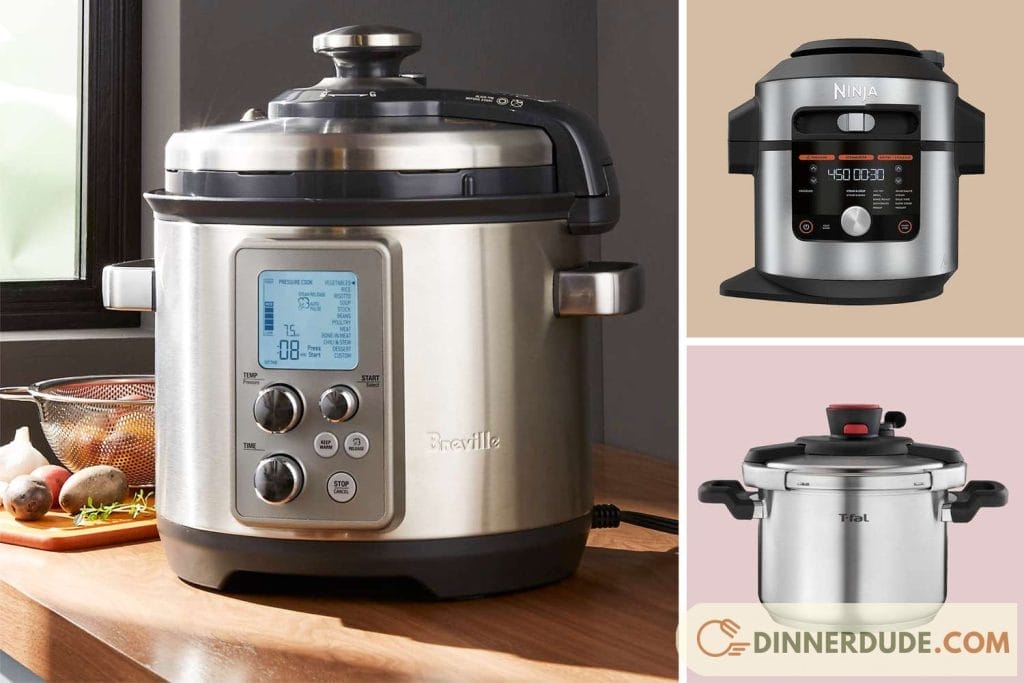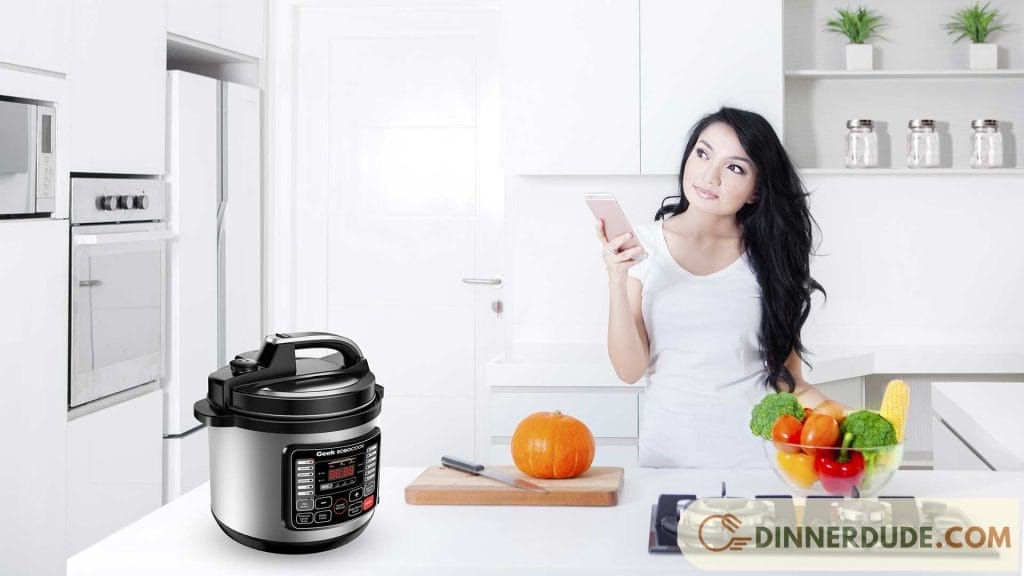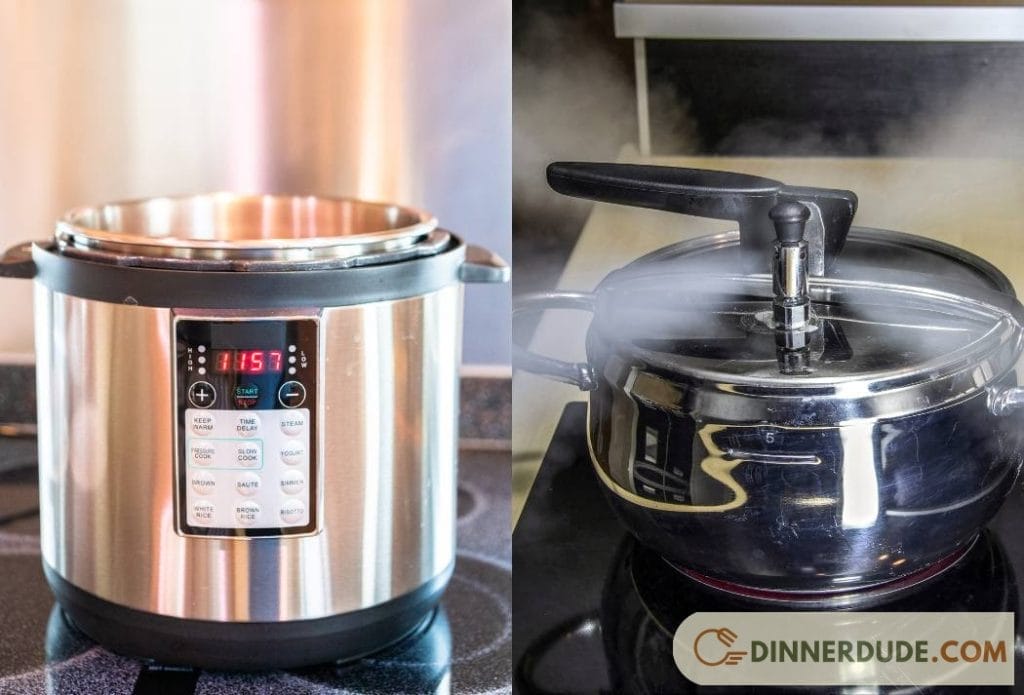Pressure cooking is an ancient cooking process that has recently become popular thanks to a new generation of stoves that offer quick, preset, and instant cooking for your family meals.
So. How does pressure cooker cook faster? All questions will be answered through Dinnerdude‘s article below.
How Pressure Cookers Work

The Science Behind Pressure Cooking
A pressure cooker operates on a simple principle: steam pressure. A sealed pot, with a lot of steam inside, builds up high pressure, which helps food cook faster.
When you heat water, it turns into steam, which is a gas that takes up more space than the liquid from which it originated. If the steam is confined within a sealed pot, it can’t expand beyond the confines of that pot.
Instead, as more steam is formed, the pressure inside the pot increases. This is because the gas molecules are colliding with the walls of the pot more frequently and with greater force.
As the pressure increases, the temperature at which water boils also rises. Normally, water boils at 100°C (212°F) at sea level, but when cooked inside a pressure cooker, the boiling point can go as high as 120-130°C (248-266°F).
This higher cooking temperature leads to faster cooking times. The increased pressure also forces moisture into the food, which can make the food tender and flavorful quickly.
Advantages of High-Pressure Cooking
The elevated pressures created inside the pressure cooker come with several culinary advantages.
First and foremost is speed. Because foods cook faster under pressure, meals can be prepared in a fraction of the time they would take using traditional methods. This makes pressure cooking an excellent option for busy individuals or families.
Furthermore, due to the shortened cooking times, nutrients that might otherwise be destroyed during long cooking processes are better retained in pressure-cooked food. This method of cooking can also save energy because less heat is wasted, and the cooker can bring the meal to temperature more efficiently.
Lastly, because all the contents are under pressure, flavors are infused into the food more intensely, often resulting in a richer taste experience.
How does pressure cooker cook faster?
A pressure cooker cooks faster primarily due to the combination of increased pressure and elevated temperatures within a sealed environment. Here’s a more detailed explanation:
| Sealed Environment | A pressure cooker has a tightly sealed lid, creating a closed system. This prevents steam and heat from escaping during the cooking process. |
| Increased Pressure | As the liquid (usually water) inside the pressure cooker heats up, it turns into steam. Since the pressure cooker is sealed, the steam cannot dissipate, causing pressure to build up inside the cooker. |
| Elevated Boiling Point | The increase in pressure also raises the boiling point of the water inside the pressure cooker. At higher pressures, water can reach temperatures above its normal boiling point (212 degrees Fahrenheit or 100 degrees Celsius at standard atmospheric pressure). |
| Improved Heat Transfer | The high pressure inside the cooker enhances heat transfer efficiency. This means that the heat is more effectively conducted into the food, ensuring even and thorough cooking. |
| Faster Cooking Time | The elevated temperature and pressure significantly accelerate the cooking process. Food cooks more rapidly in this high-pressure, high-temperature environment, reducing cooking times compared to conventional methods. |
| Tenderizing Effect | The combination of high pressure and elevated temperature also has a tenderizing effect on tough cuts of meat. The pressure helps to break down collagen and connective tissues, resulting in tender and flavorful dishes in a shorter amount of time. |
The sealed and pressurized environment of a pressure cooker allows for faster cooking by raising the boiling point of the cooking liquid, improving heat transfer, and creating conditions that speed up the cooking process significantly.
Practical Applications of Pressure Cooking

Cooking Various Foods
Pressure cookers are versatile kitchen appliances that can be used to cook a wide range of foods. They are particularly effective for cooking tougher cuts of meat, which benefit from the moist heat and high pressure that help break down tough fibers.
Legumes like beans and lentils, which usually require long soaking and cooking times, can be prepared much more rapidly in a pressure cooker without pre-soaking.
Similarly, grains such as rice and barley can be cooked in a pressure cooker in a fraction of the time required by traditional methods.
The pressure cooker’s environment is also good for preparing stews, soups, and broths, as it can extract flavor from ingredients quickly and efficiently.
Tips for Successful Pressure Cooking
To ensure successful pressure cooking, it’s important to follow specific guidelines. Always check the manufacturer’s instructions before using a pressure cooker, as different models may have different capacities and features.
It’s crucial not to overfill the cooker, as this could prevent steam from circulating properly or cause food to block the pressure release valves.
Additionally, consider the cooking times of different ingredients; if a recipe calls for ingredients that cook at different rates, add the longer-cooking items first and the quicker ones later.
Finally, be sure to release the pressure safely according to the cooker’s instructions, either naturally or through a quick-release method, to ensure that the food stops cooking at the right time and to avoid accidents.

How does pressure cooker cook faster? In conclusion, pressure cookers provide a rapid, energy-efficient, and nutritious method of preparing a variety of dishes. By understanding the principles behind pressure cooking and adhering to best practices, anyone can harness the power of steam to create delicious meals in a fraction of the usual time.